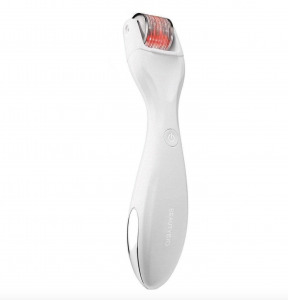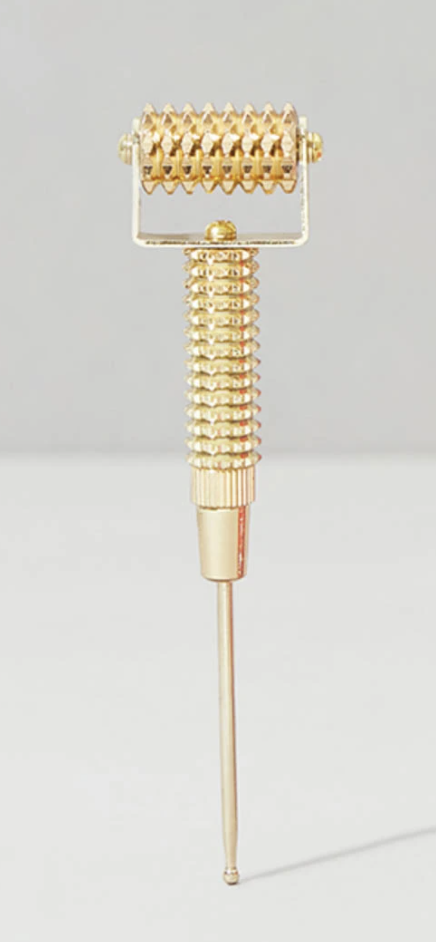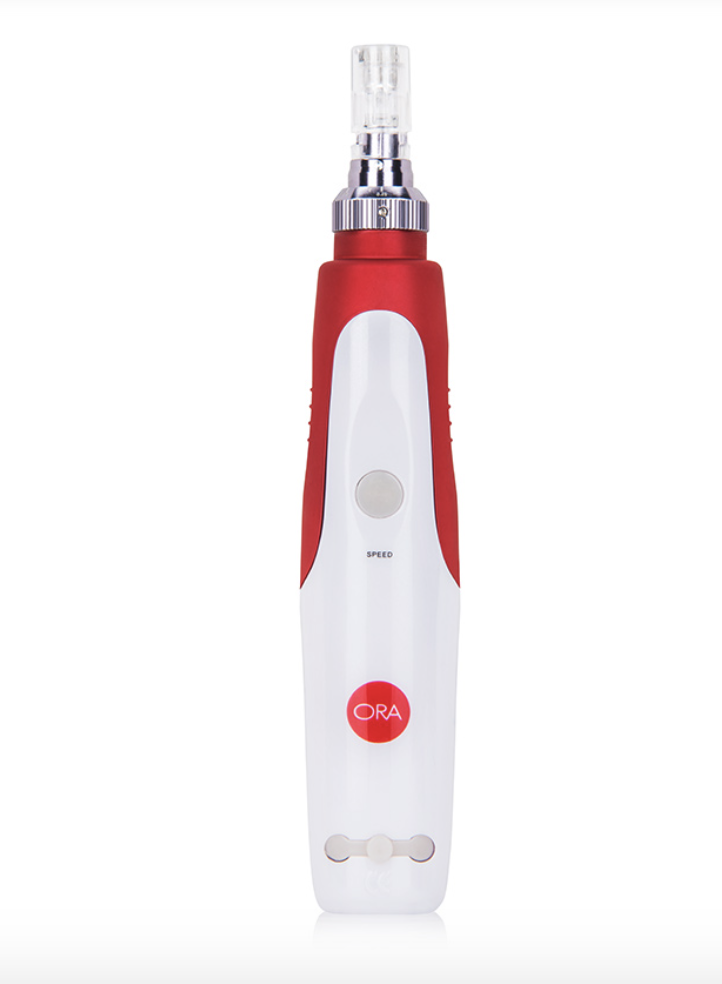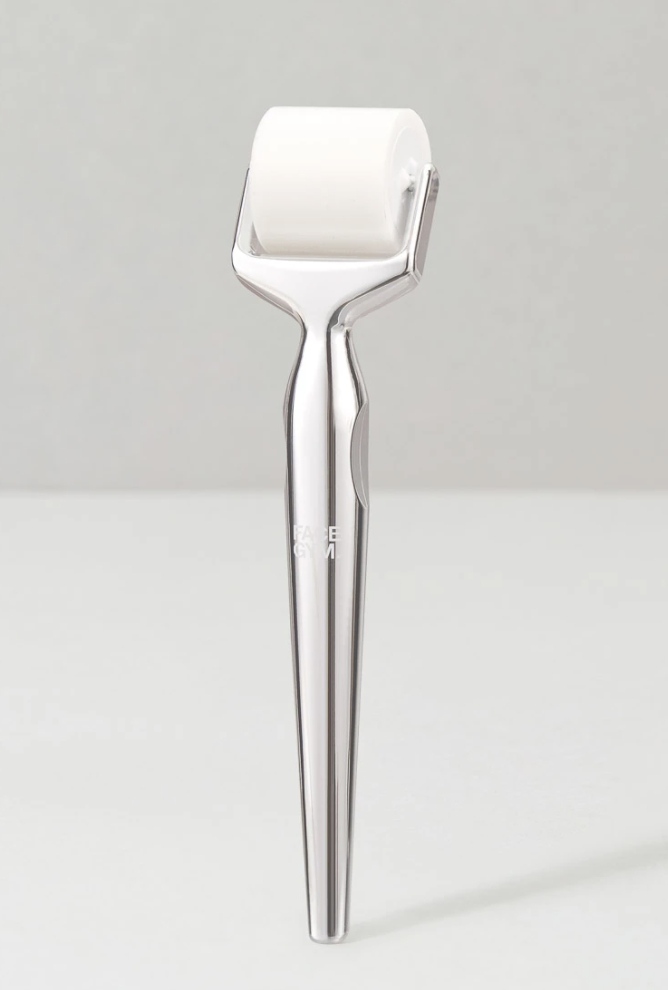Featured Image Source
Microneedling has many benefits to prevent aging skin. We’ve already talked about one anti-aging remedy in our article about collagen water, but microneedling speeds up anti-aging results. We’re here to tell you all about what microneedling is, how to do it yourself, and the costs of getting this treatment done with a practitioner versus at home.

What Is Microneedling And What Does It Do?
Collagen induction therapy, aka microneedling, is a cosmetic procedure that involves repeatedly puncturing the skin with tiny, sterile needles. The idea is that the slight “damage” caused by the needles will send out elastin and collagen to repair the skin.
View this post on Instagram
Microneedling typically requires four to six sessions that are spaced out about a month apart. During the procedure, a topical anesthetic is applied. Then, a derma roller is used to insert the needles into the skin to cause punctures.
After the procedure, a collagen-enhancing serum is applied. The purpose of this treatment is to generate new collagen and skin tissue for skin that is firmer, smoother, and more toned.
View this post on Instagram
You can have microneedling done pretty much anywhere that needs a collagen boost. It’s can also be used to treat wrinkles, acne scars, and large pores. The treatment is safe for people who are in good health but not recommended for pregnant women or anyone who uses certain acne medications. If any of the following apply to you, you should most likely avoid microneedling:
– Keloid or raised scarring
– History of eczema, psoriasis and other chronic conditions
– History of actinic (solar) keratosis
– History of herpes simplex infections
– History of diabetes
– Presence of raised moles, warts or any raised lesions on targeted areas
Microneedling Explained By Jamie O’Banion:
Click Here To Learn More
At-Home Microneedling Products
If you decide to try microneedling at home, one product we highly recommend is GloPRO. The Red LED Light Therapy combines with stainless steel microneedles and a pulse function, allowing for deep penetration. This helps to stimulate new skin cells, increase collagen and elastin production, and therefore firm and tone skin. It also increases the absorption of topical skincare, so you fully reap the benefits of your products. There are an array of different heads/attachments for different areas including lips, eyes, even body for treatment of crepey or saggy skin and scalp for hair growth. Want it all? Buy the set for significant savings. It runs off of long-lasting batteries and can be replaced easily with two triple A batteries.
You can also purchase other kits and dermarollers to do a microneedling treatment yourself, although you should always talk to your dermatologist first. The best approach to at-home microneedling treatments is to invest in a good quality dermaroller from a reputable supplier. These are our recommendations:
How To Microneedle At Home
View this post on Instagram
If you’re choosing to microneedle at home, it’s crucial to do it safely. Below are all the steps to microneedle properly:
1. You should never microneedle if you have active acne, extremely sensitive skin, rosacea, cold sores, or cuts. Your skin will be a little pink from the treatment, so we recommend doing it at night. Be sure to start off using a derma roller once a week, eventually working up to three to five times a week.
2. After you’ve applied your serum of choice to your skin, apply a small amount of pressure and roll the microneedle over your skin vertically, horizontally, and diagonally. “You should do two to four passes vertically, followed by another two to four rolls horizontally on the same section. Then, move on to the next area,” according to an article by instyle. Next, apply another layer of serum.
3. Once you’ve derma-rolled every part of your face, wait a few minutes before applying any other creams or lotions. Since microneedling enhances product absorption, it’s a good idea to use caution when applying certain active ingredients like alpha hydroxy acids or retinol because these products can irritate the skin. If you use the GloPro, we recommend their companion products which can be applied immediately.
4. As soon as you’re done using your derma roller, be sure to sterilize it in alcohol or a specialized cleaner for three to five minutes and let it air-dry before storing it back in its original container. GloPro comes with a sanitizing spray you should use each time.
5. Replace your derma roller once its time is up. Your first roller should last about three months, but if you use yours regularly, invest in a new one every month — the needles will dull quickly.
In-Office Microneedling
View this post on Instagram
If you decide to do in-office treatment, any intense topical treatments should be discontinued a few days before your appointment, because harsh products can aggravate your skin. Be sure to avoid direct sun exposure three days before and three days after the treatment.
When you arrive at your appointment, your skin should be as clean and dry as possible, so don’t wear makeup. Once your skin is thoroughly cleaned, the physician will apply numbing cream to lessen any possible discomfort. When the treatment is finished, after-care is essential.
After Treatment:
– Do not take any anti-inflammatory medications for one week after the procedure.
– Do not use ice on your face, and avoid using arnica/bromelain. These may interfere with the natural inflammatory process that’s critical for your skin rejuvenation.
– Avoid sun tanning and prolonged exposure to direct sunlight for at least two weeks. After 24 hours, always use sunblock (30 SPF or higher) and wear a hat if you’re outside.
– Use a painkiller, such as Tylenol, if you experience any soreness.
– Avoid activities that cause sweating for up to 48 hours.
– Only use mineral makeup after 24 hours.
– Sleep on your back with your head elevated to minimize swelling or pain as needed.
– Around five days after the treatment, you may begin to go back to your normal skincare routine.
What Are The Risks?
View this post on Instagram
Like any procedure, there are risks to microneedling that you should be aware of. First and foremost, it can potentially cause complications such as bleeding, bruising, infection, scarring, and pigment problems.
If you’re microneedling at home, there are certain risks that may not occur in-office. For example, at-home devices used for microneedling are more difficult to clean, and not thoroughly cleaning a microneedling device can increase the risk of infection or injury.
What Are The Costs?
Considering microneedling? Get the average cost of the treatment in your area: https://t.co/nL17XD2TSP pic.twitter.com/yiHHXwaZbf
— RealSelf (@realself) June 26, 2018
In-office microneedling can cost anywhere from $200 to $700 per session. However, the number of sessions may vary, and most people need three to six sessions for optimal results. Keeping this in mind, you may spend anywhere from $600 to $4,200 overall. Overall, it’s more cost-efficient to microneedle at home.

Would you give microneedling treatments a try? Let us know in the comments below!
For More Skincare Articles, You Should Read:
Here’s The Exact Order Your Skincare Routine Should Follow Day And Night
Soothing Gua Sha Beauty Tools That Will Rejuvenate Your Skin





